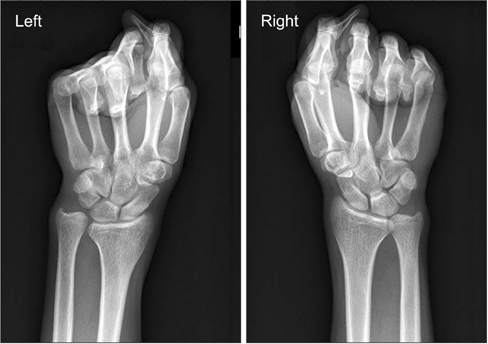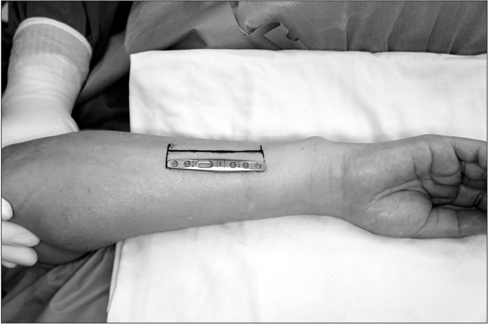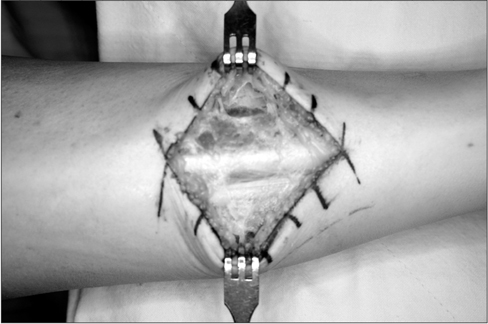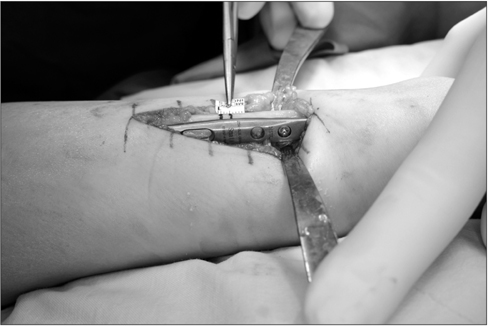J Korean Orthop Assoc.
2017 Apr;52(2):103-111. 10.4055/jkoa.2017.52.2.103.
Updates on Ulnar Impaction Syndrome
- Affiliations
-
- 1Department of Orthopaedic Surgery, Seoul National University College of Medicine, Seoul, Korea. ghbaek@snu.ac.kr
- KMID: 2438975
- DOI: http://doi.org/10.4055/jkoa.2017.52.2.103
Abstract
- Ulnar impaction syndrome is one of the common causes of ulnar-sided wrist pain. The pain is usually aggravated by ulnar deviation during a power grip, especially when the forearm is in a pronated position. The most common predisposing factor of ulnar impaction syndrome is ulnar positive variance, which is an increased ulnar length relative to the radius of the radiocarpal joint. However, it can also occur in patients with ulnar neutral or negative variance because ulnar variance can increase during functional activities, including pronation and power gripping. In these patients, the triangular fibrocartilage complex (TFCC) may be thickened. If conservative treatments"”lifestyle modification, medication, or wrist splinting"”are unsuccessful, surgical treatments, such as wafer procedure or ulnar shortening osteotomy can be considered. The wafer procedure is an effective treatment for ulnar impaction syndrome. It removes the distal 2 to 4 mm of the ulnar head, while preserving the ulnar styloid process from fracturing via a limited open or an arthroscopic approach. The advantages of the wafer procedure are that it does not require bone healing or internal fixation and provides direct access to TFCC. However, it is a technically demanding procedure and is contraindicated in patients with distal radio-ulnar joint (DRUJ) instability, lunotriquetral instability, ulnar minus variance, and with an ulnar positive variance of more than 4 mm. Ulnar shortening osteotomy is the most popular method for the treatment of ulnar impaction syndrome. It can effectively relieve ulnar impaction symptoms and stabilize DRUJ. However, an excessive amount of shortening may increase the peak pressure at DRUJ, which results in DRUJ arthritis. There is also a possibility of delayed union or nonunion in the osteotomy site. To prevent delayed union or nonunion, we should make an effort to decrease the gap in the osteotomy site during surgery. A serial follow-up is also recommended to evaluate the occurrence of arthritis in DRUJ after ulnar shortening.
MeSH Terms
Figure
Cited by 1 articles
-
Ulnar impaction syndrome: how to diagnose and treat?
Hyun Sik Seok, Jong Woong Park, Jong Woo Kang
Arch Hand Microsurg. 2022;27(2):105-118. doi: 10.12790/ahm.21.0149.
Reference
-
1. Tomaino MM. Ulnar impaction syndrome in the ulnar negative and neutral wrist. Diagnosis and pathoanatomy. J Hand Surg Br. 1998; 23:754–757.2. Friedman SL, Palmer AK. The ulnar impaction syndrome. Hand Clin. 1991; 7:295–310.
Article3. Coleman DA, Blair WF, Shurr D. Resection of the radial head for fracture of the radial head. Long-term follow-up of seventeen cases. J Bone Joint Surg Am. 1987; 69:385–392.4. Chun S, Palmer AK. The ulnar impaction syndrome: follow-up of ulnar shortening osteotomy. J Hand Surg Am. 1993; 18:46–53.
Article5. Loh YC, Van Den Abbeele K, Stanley JK, Trail IA. The results of ulnar shortening for ulnar impaction syndrome. J Hand Surg Br. 1999; 24:316–320.
Article6. Baek GH, Chung MS, Lee YH, Gong HS, Lee S, Kim HH. Ulnar shortening osteotomy in idiopathic ulnar impaction syndrome. J Bone Joint Surg Am. 2005; 87:2649–2654.
Article7. Yeh GL, Beredjiklian PK, Katz MA, Steinberg DR, Bozentka DJ. Effects of forearm rotation on the clinical evaluation of ulnar variance. J Hand Surg Am. 2001; 26:1042–1046.
Article8. Tomaino MM. The importance of the pronated grip x-ray view in evaluating ulnar variance. J Hand Surg Am. 2000; 25:352–357.
Article9. Parker AS, Nguyen M, Minard CG, Guffey D, Willis MH, Reichel LM. Measurement of ulnar variance from the lateral radiograph: a comparison of techniques. J Hand Surg Am. 2014; 39:1114–1121.
Article10. Lee JI, Suh DH, Byun JS, et al. Radiographic appearance and patient outcome after ulnar shortening osteotomy for idiopathic ulnar impaction syndrome. J Hand Surg Am. 2012; 37:975–981.
Article11. Iwatsuki K, Tatebe M, Yamamoto M, et al. Ulnar impaction syndrome: incidence of lunotriquetral ligament degeneration and outcome of ulnar-shortening osteotomy. J Hand Surg Am. 2014; 39:1108–1113.
Article12. Palmer AK. Triangular fibrocartilage complex lesions: a classification. J Hand Surg Am. 1989; 14:594–606.
Article13. Oda T, Wada T, Iba K, Aoki M, Tamakawa M, Yamashita T. Reconstructed animation from four-phase grip MRI of the wrist with ulnar-sided pain. J Hand Surg Eur Vol. 2013; 38:746–750.
Article14. Woitzik E, deGraauw C, Easter B. Ulnar impaction syndrome: a case series investigating the appropriate diagnosis, management, and post-operative considerations. J Can Chiropr Assoc. 2014; 58:401–412.15. Griska A, Feldon P. Wafer resection of the distal ulna. J Hand Surg Am. 2015; 40:2283–2288.
Article16. Colantoni J, Chadderdon C, Gaston RG. Arthroscopic wafer procedure for ulnar impaction syndrome. Arthrosc Tech. 2014; 3:e123–e125.
Article17. Meftah M, Keefer EP, Panagopoulos G, Yang SS. Arthroscopic wafer resection for ulnar impaction syndrome: prediction of outcomes. Hand Surg. 2010; 15:89–93.
Article18. Bickel KD. Arthroscopic treatment of ulnar impaction syndrome. J Hand Surg Am. 2008; 33:1420–1423.
Article19. Yin HW, Qiu YQ, Shen YD, Xu JG, Gu YD, Xu WD. Arthroscopic distal metaphyseal ulnar shortening osteotomy for ulnar impaction syndrome: a different technique. J Hand Surg Am. 2013; 38:2257–2262.
Article20. Nagle DJ, Bernstein MA. Laser-assisted arthroscopic ulnar shortening. Arthroscopy. 2002; 18:1046–1051.
Article21. Tomaino MM, Shah M. Treatment of ulnar impaction syndrome with the wafer procedure. Am J Orthop (Belle Mead NJ). 2001; 30:129–133.22. McBeath R, Katolik LI, Shin EK. Ulnar shortening osteotomy for ulnar impaction syndrome. J Hand Surg Am. 2013; 38:379–381.
Article23. Boardman MJ, Imbriglia JE. Surgical management of ulnocarpal impaction syndrome. J Hand Surg Am. 2010; 35:649–651. quiz 651.
Article24. Moermans A, Degreef I, De Smet L. Ulnar shortening osteotomy for ulnar ideopathic impaction syndrome. Scand J Plast Reconstr Surg Hand Surg. 2007; 41:310–314.
Article25. Tomaino MM, Weiser RW. Combined arthroscopic TFCC debridement and wafer resection of the distal ulna in wrists with triangular fibrocartilage complex tears and positive ulnar variance. J Hand Surg Am. 2001; 26:1047–1052.
Article26. Koeppel M, Hargreaves IC, Herbert TJ. Ulnar shortening osteotomy for ulnar carpal instability and ulnar carpal impaction. J Hand Surg Br. 1997; 22:451–456.27. Rayhack JM, Gasser SI, Latta LL, Ouellette EA, Milne EL. Precision oblique osteotomy for shortening of the ulna. J Hand Surg Am. 1993; 18:908–918.
Article28. Rajgopal R, Roth J, King G, Faber K, Grewal R. Outcomes and complications of ulnar shortening osteotomy: an institutional review. Hand (N Y). 2015; 10:535–540.
Article29. Cantero J. Reestablishment of supination by shortening the cubitus in complications of Pouteau-Colles fractures (new technic). Z Unfallmed Berufskr. 1974; 67:135–137.30. Cantero J. Shortening of the ulna following fracture of the distal end of the radius (author's transl). Ann Chir. 1977; 31:330–334.31. Chen NC, Wolfe SW. Ulna shortening osteotomy using a compression device. J Hand Surg Am. 2003; 28:88–93.
Article32. Wehbé MA, Cautilli DA. Ulnar shortening using the AO small distractor. J Hand Surg Am. 1995; 20:959–964.
Article33. Lautenbach M, Millrose M, Schmidt NS, Zach A, Eichenauer F, Eisenschenk A. Ulnocarpal impaction syndrome: treatment with a transverse ulnar shortening osteotomy from an ulnodorsal approach. Arch Orthop Trauma Surg. 2014; 134:881–885.
Article34. Hammert WC, Williams RB, Greenberg JA. Distal metaphyseal ulnar-shortening osteotomy: surgical technique. J Hand Surg Am. 2012; 37:1071–1077.
Article35. Nunez FA Jr, Barnwell J, Li Z, Nunez FA Sr. Metaphyseal ulnar shortening osteotomy for the treatment of ulnocarpal abutment syndrome using distal ulna hook plate: case series. J Hand Surg Am. 2012; 37:1574–1579.
Article36. Arimitsu S, Moritomo H, Kitamura T, et al. The stabilizing effect of the distal interosseous membrane on the distal radioulnar joint in an ulnar shortening procedure: a biomechanical study. J Bone Joint Surg Am. 2011; 93:2022–2030.
Article37. Nishiwaki M, Nakamura T, Nagura T, Toyama Y, Ikegami H. Ulnar-shortening effect on distal radioulnar joint pressure: a biomechanical study. J Hand Surg Am. 2008; 33:198–205.
Article38. Pouliot M, Yao J. Ulnar shortening osteotomy utilizing a TriMed ulnar osteotomy system. Tech Hand Up Extrem Surg. 2014; 18:72–76.
Article39. Martin DE, Zlotolow DA, Russo SA, Kozin SH. Comparison of compression screw and perpendicular clamp in ulnar shortening osteotomy. J Hand Surg Am. 2014; 39:1558–1564.
Article40. Das De S, Johnsen PH, Wolfe SW. Soft tissue complications of dorsal versus volar plating for ulnar shortening osteotomy. J Hand Surg Am. 2015; 40:928–933.
Article41. Baek GH, Chung MS, Lee YH, Gong HS, Lee S, Kim HH. Ulnar shortening osteotomy in idiopathic ulnar impaction syndrome. Surgical technique. J Bone Joint Surg Am. 2006; 88:Suppl 1 Pt 2. 212–220.42. Tolat AR, Sanderson PL, De Smet L, Stanley JK. The gymnast's wrist: acquired positive ulnar variance following chronic epiphyseal injury. J Hand Surg Br. 1992; 17:678–681.
Article43. Baek GH, Lee HJ, Gong HS, et al. Long-term outcomes of ulnar shortening osteotomy for idiopathic ulnar impaction syndrome: at least 5-years follow-up. Clin Orthop Surg. 2011; 3:295–301.
Article44. de Runz A, Pauchard N, Sorin T, Dap F, Dautel G. Ulna-shortening osteotomy: outcome and repercussion of the distal radioulnar joint osteoarthritis. Plast Reconstr Surg. 2016; 137:175–184.
- Full Text Links
- Actions
-
Cited
- CITED
-
- Close
- Share
- Similar articles
-
- Arthroscopy of the Wrist and Ulnar Shortening Osteotomy for the Treatment of the Ulnar Impaction Syndrome
- Ulnar impaction syndrome: how to diagnose and treat?
- Treatment of Ulnar Impaction Syndrome using Arthroscopy and Ulnar Shortening Osteotomy
- Intraoperative Arthroscopic Findings of Ulnar Impaction Syndrome
- Ulnar Shortening Osteotomy for the Treatment of Ulnar Impaction Syndrome









